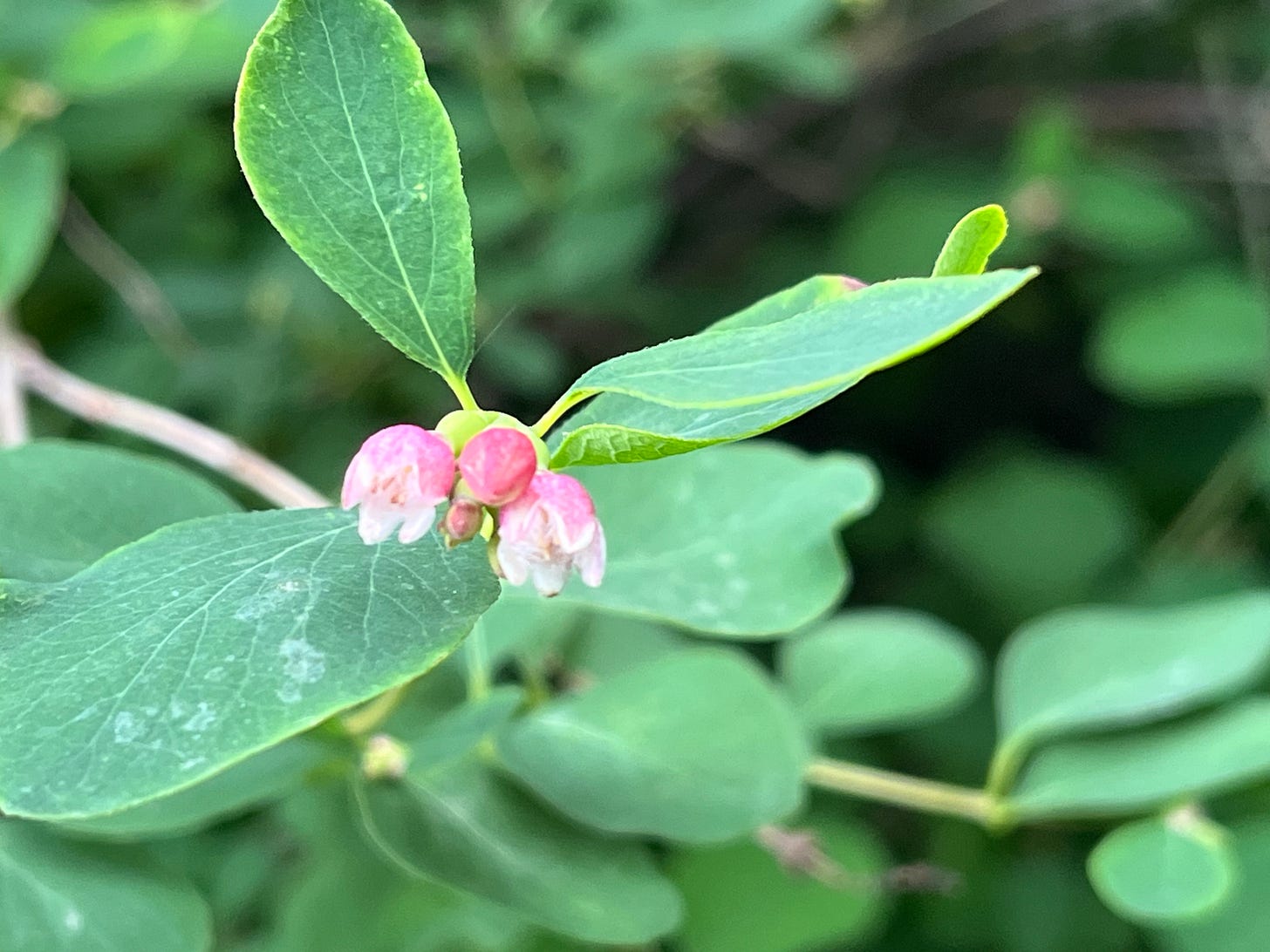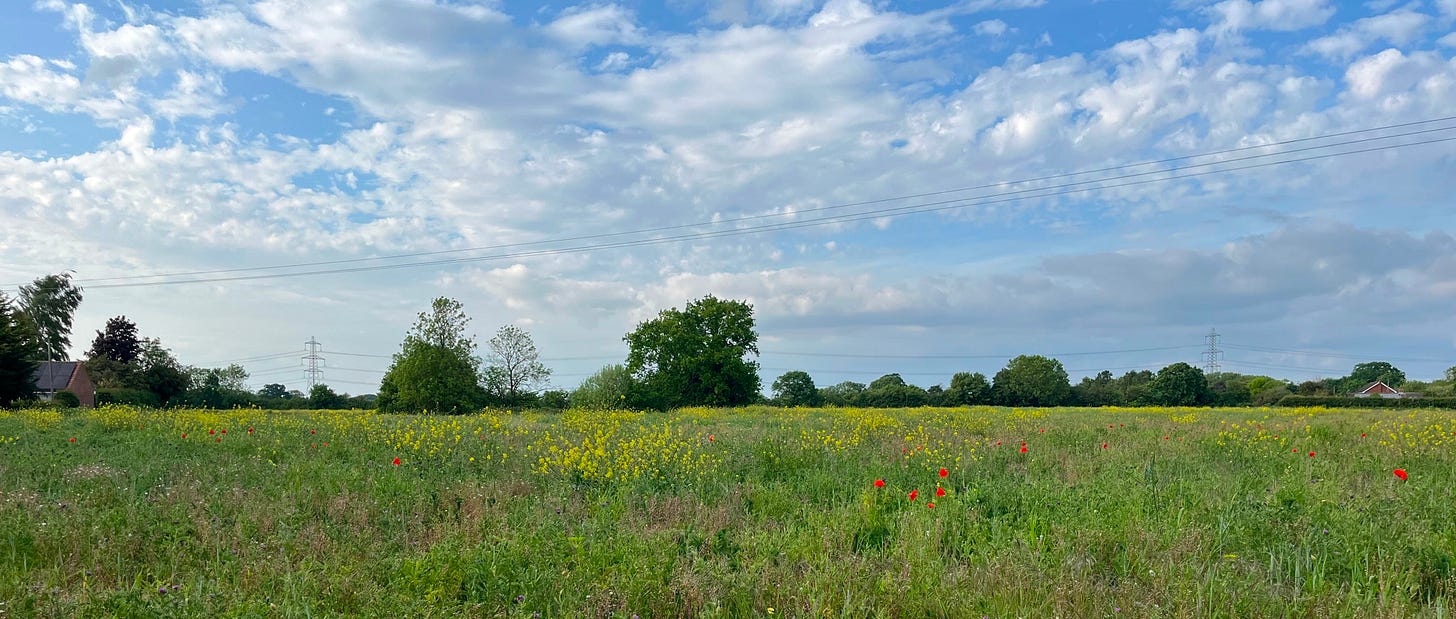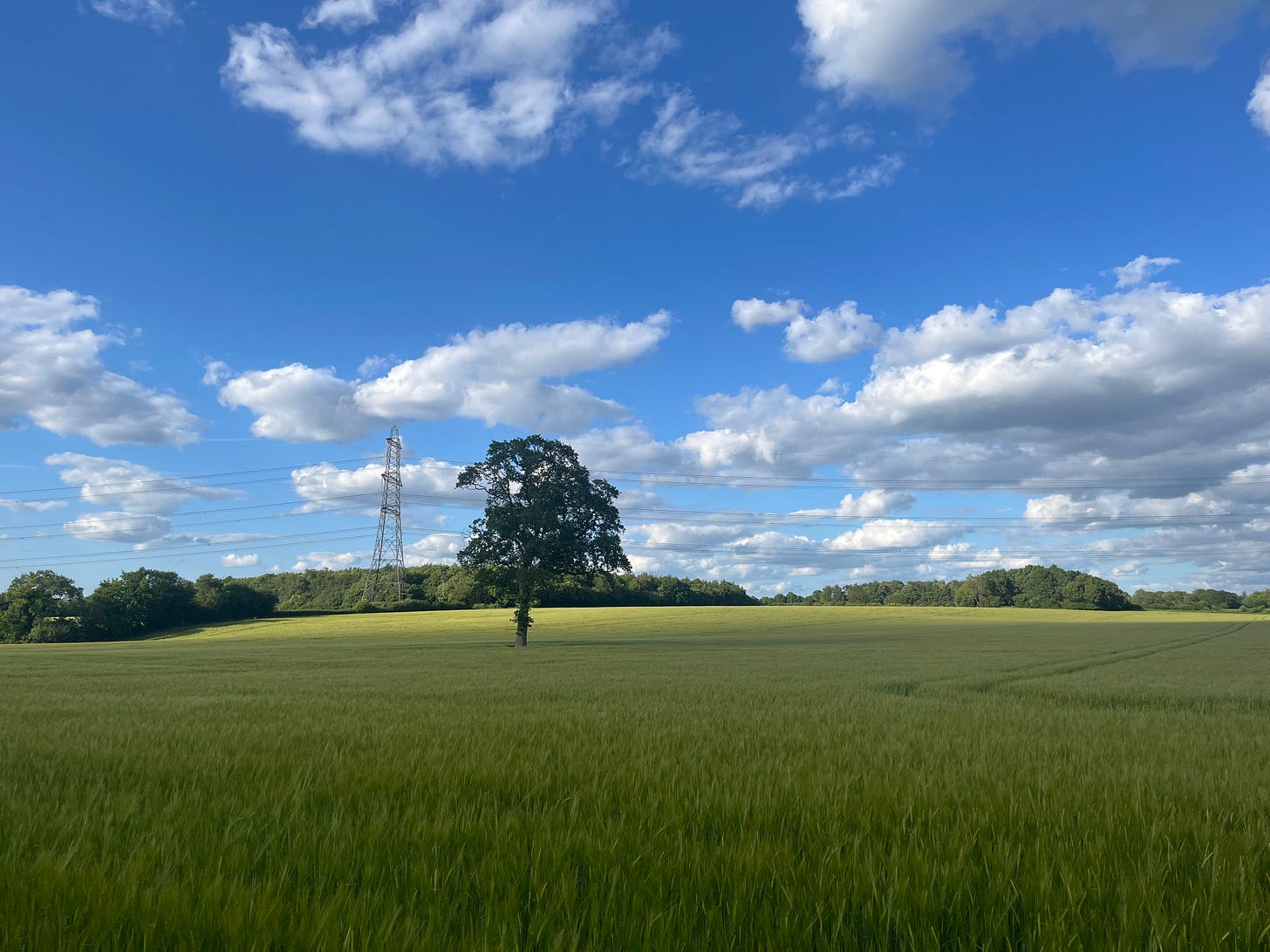24/5
The air smells ripe after the rain. The overcast skies have given way to early evening sunshine and a brisk wind. Despite the wind, the air feels muggy. The smell, I decide, is a combination of flowering plants releasing pollen after the rain, and the sickly smell of flowers that have peaked and have started to decay. A smell that is almost like spilt beer. On the bridleway, as it passes by the old orchard, we spot the pink buds of the snowberry among the soft leaves of the their bushes. They give off a sweet perfume like roses, potent for such a tiny flower.
Spring is rushing into summer in a frenzy of flower. All along the verges of the bridlepath; red campion, cow parsley, common vetch, forget-me-nots, oxeye daisies, creeping buttercup, greater stitchwort. Such extraordinary common names. Why oxeye? Because it is as large as an ox’s eye? It’s also known as the moon daisy because if the way it glows in moonlight. There are clumps of it here and there—some in the middle of the path growing in the indentation made by thousands of feet over a hundred years or so. In the same boot-worn groove a row of sapling oak trees grow, self seeded from the parent trees in the hedge. The acorns fall and collect in the groove, which collects leaf litter and water to create a humus perfect for the germination of the seeds. The saplings never get very high, but the persistence of growth, of nature, of life, to keep on striving wherever there is an opportunity is somehow humbling. This is the lesson that spring brings after it unwraps the burial shroud of winter. This rising rejuvenation. This resurrection.
As we walk through the old brickyard woods and onto the road the wind seems to pick up, the branches of the beeches and limes jostling, the leaves pushed and tousled with a vast rushing and sighing. Some of the trees on the other side of the road have been thinned and we find a large stack of the trunks blocking a field entrance further along—no doubt strategically placed to prevent anyone accessing the field for fly-tipping. As most of the farming here is arable, many of the field entrances lack gates, making it easy for someone to slip into a field with a vehicle.
Every field view feels like a landscape painting this evening, something by Alfred Munnings perhaps. Wide fields, big skies of crumbled cloud, the light touching the ripening crops, or lighting the yellows and reds of stray rapeseed and opportunist poppies.
25/5
It is much warmer this morning. The wind is strong from the west, buffeting the chimney so that the sound of it echoes into the living room. Clouds pass all the time, the light rising and falling in waves. When I go out to hang the washing the breeze feels cooler than yesterday, but the mugginess remains, and almost as soon as the last item is hung, it begins to spit lightly with rain from one of the fast moving rags of cumulus—not quite enough to justify pulling everything off the line. The great tits are scolding me (or the cat) from either end of the garden. Chiffchaffs intone their chirpy refrain. Sparrows chatter noisily from the roof as I fill the wheelbarrow with bark to set around newly planted shrubs and flowers, and around the base of the purple elder, which suffers so badly in dry weather.
More of the potatoes have started to flower and more are beginning to bud. We will probably be able to dig up out first crop in June.
Later, in the late afternoon sun, we walk into the dry brisk wind toward our long walking circuit over to the next parish. Along the verges of the main road out of the village we add to out list of extraordinary names for wildflowers with dames rocket, common mallow, and red clover. Along the lanes Ceci notices the way beetle grubs have left patterns like some sort of writing on the dead wood of an old oak where the bark has fallen away. It looks like a palimpsest of graffiti written in ancient glyphs.
By the hollow next to the track up to ‘the top’, the rabbits are still at their work of eating the rye. Three of them hop into the thicket of nettle and bramble as we approach. They’ve chewed back another metre or so on either side, and have gone a row or two deeper.
We follow the path down from ‘the top’ along the ancient hedgerow and into the bottom fields. A couple are still uncultivated, full of creeping buttercups, clumps of oxeye daisies, thistles, red campion, and white mustard. We add a further wildflower to the list with the remarkably named heart-podded hoary cress. It is flowering with crowns of small white flowers, low to the ground. The area it is growing in is next to a small copse that we suspect once held a cottage. The copse is bounded by elder trees and collapsing oaks. The footpath from the nearby church runs straight across the field to the copse, making me think that there was once a dwelling here.
The wheat in the wide fields is moving in waves beneath the constantly shifting light. A swallow scythes overhead, circling a field oak. They seem to have dispersed to nesting sights now, and throughout the walk we seem them in ones or twos in their fast pursuits of insects.
On the way back through the lanes we catch sight of a roe deer deep in a field of wheat, its head and flank just visible like a swimmer. Every so often it would vanish to eat, then surface again, ever vigilant. By the stream that passes beneath the lane we find some fly-tipped junk. Some sort of bedroom furniture, a smashed mirror—seven years back luck for whoever dumped this I hope—a plastic garden bucket full of something oil black and decomposed.
When we get home I look on a website of old historic maps in search of the cottage in the old copse, but find instead, that it is marked on the tithe and enclosure maps as a pebble and gravel pit.
26/5
We find a dead fledgling great tit close to where they’ve been nesting in the ‘sparrow hotel’ nest box. I’m hoping the others fledged successfully.
As Ceci disposes of it I catch a glimpse of something slicing an arc through the sky. Swifts I think, I hope.
28/5
There is welcome rain for twenty-four hours. The lawn that looked brown after I’d cut it at the weekend has greened over. The lupins loll sideways under the weight of their blooms and the water. The potato plants are full leafed in the beds. The sun begins to break through the cloud mid morning. The wind has dropped. Fast jets score the skies with their roars.
29/5
The air feels dense with warmth, muggy despite the brisk south-westerly wind. I have booked a day of annual leave, but don’t quite know what to do with it. I examine the potato plants. More of them are flowering. The flower of the potato is underrated and overlooked. It is delicate, almost like a bee orchid. The flower is generally purplish with a bright yellow centre. I watch a hoverfly visiting one after another. I worry that I planted the seed potatoes too deep, that all their energy will have gone into reaching the light, and that the potatoes will rot for being too far down in the moist soil. I will give the first flowering plants a few days before doing a test dig on one of the more promising ones to see how things are fairing.
Before lunch the man arrives to pump out the septic tank. He has been here before and we chat about my old land rover and the best approach for valuing it. He locks together various lengths of flexible hose between the septic tank underground and the large cylindrical tank that is pulled behind a bright yellow tractor. The engine of the tractor works the pump and the machine begins to suck away all our crap, eighteen months worth. I’m glad it’s windy. On still days the stench seems to permeate the fabric of the house. The man crouches on the ground beneath our rose bushes and watches the level of the tank fall. The contents will be treated and used as manure, at least that’s my understanding. Even shit has a recyclable value.
30/5
The wood is clothing itself for summer. The baby leaves are toughening, the hue of the greens darkening. Everything is now in leaf. The nettles are rising. The understory is looking fuller, more secretive. Even on a bright warm morning like this the woods feel shady and cool. It is like stepping through a portal where the rules of normal reality work differently. Time seems to slow. Distance becomes difficult to judge. It’s easier to lose your bearings in a summer wood.
Two sets of ears turn sharply towards me from the bracken. The ears are attached to two roe deer. I spot them as they spot me. They must be about 20 meters away. I stop and keep perfectly still, moving only to turn on the camera setting on my phone. As close as I am my phone can’t get a decent shot. I creep forwards and they bolt, leaping further into the woodland interior. They are curiously silent as they move. Often deer crash through the undergrowth when alarmed, but these vanish like ghosts.
In the bluebell woods, the flowers have now all given way to a sea of pale green seed heads. Green dominates, but here and there pink and cream foxgloves spear upward. I follow the track towards the carr, where we own our three-acre plot. As I get closer to the water the bird song increases, and I stand first, under the old stag oak at the centre of the carr, and then under the largest beech tree in the wood, and try to identify them. There is a robin, wren, blackcap—these three dominate—but also the shrill notes of a goldcrest, the brief yaffle of a green woodpecker, a blackbird, a song thrush, and woodpigeons. The woodpecker is hammering away on a tree somewhere.
We bought this wood when our daughters were small. Tens years have almost passed, I realise with a jolt. The girls are now teenagers and seldom accompany us to the woods. On one of our first visits we built a shelter and made a small fire, and for years afterwards the remains of the shelter slowly collapsed. I search for it and find nothing. The wood persists and will outlast all of us, at least it will now that we have saved it from the certain destruction of the cancelled road. The wood will persist and the only traces we might leave are the small acts of care we have put into looking after it.
Many thanks to those of you who have upgraded your subscriptions to support my writing on here. Thanks are also due to those Substackers recommending this page: History, Landscape, Birds, and Stories; Hinterland; All My Old Haunts; The Guild of Master Procrastinators; Another Disappointing Walk, and Some Flowers Soon.
If you’d prefer not to upgrade but would still like to show your financial appreciation, you can also use my Stripe tip jar.
About ‘This Party’s Over’
On ‘This Party’s Over’ I publish my creative non-fiction, personal essays, place writing, and a country diary. My ‘Another Country Diary’ pieces are my most regular posts (about three a month).
The country diary can express a sort of local distinctiveness, explore a personal set of interactions with a landscape, and in doing so, almost accidentally, tease out the way the natural world is entwined with culture and politics. It can be a quietly radical and uncanny form, or sometimes just plain parochial, oddball in its specificity.
If you enjoyed this post, then follow the link to the last one to read more, and, if you are feeling in the mood to, like, share, and subscribe for free.
Another Country Diary #27
This Party's Over is a reader-supported publication. To receive new posts and support my work, consider becoming a free or paid subscriber.










I’ve been looking up the fascinating names of wildflowers too this week e.g. toadflax. My favourite go-to book is the Reader’s Digest guide to wild flowers — absolutely packed with lore.
Iain- I love the ancient glyphs imagery! And you’re absolutely right. Certain natural formations do have that texture! Great eye.